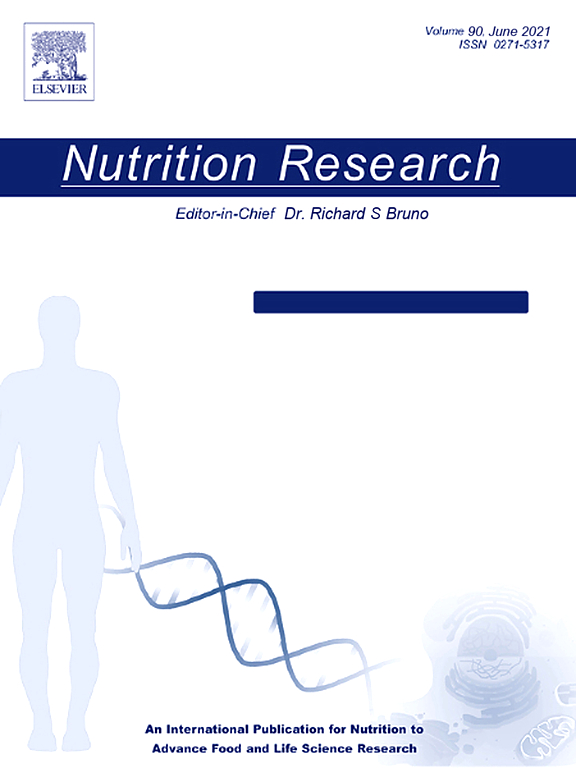转型时代高收入海湾国家人口的饮食质量:以科威特为例。
IF 3.1
3区 医学
Q2 NUTRITION & DIETETICS
引用次数: 0
摘要
饮食是心血管疾病(CVD)的可改变危险因素。虽然科威特心血管疾病的发病率正在上升,但对科威特人口饮食摄入量的研究却很少。本研究旨在利用第一次也是唯一一次全国营养调查来评估科威特成年人的全国代表性样本的饮食质量。对980名年龄在20岁或以上的成年人进行24小时饮食回顾,评估他们的饮食摄入量。饮食质量采用美国心脏协会(AHA)饮食评分进行评估。对总样本的摄入和AHA成分得分进行分析,并使用调整了抽样权重的复杂调查回归模型按年龄和性别分层。平均AHA饮食评分(最高80分)为42.5±0.46。超过70%的成年人摄入的水果/蔬菜、全谷物、鱼类/贝类和坚果/种子/豆类不足,近80%超过饱和脂肪限制,超过95%超过钠建议摄入量。饮食质量评分随年龄的增长而显著升高(P < 0.0001),老年人(≥60岁,评分= 49.4)得分显著高于年轻人(本文章由计算机程序翻译,如有差异,请以英文原文为准。
Diet quality of a population from a high-income gulf country in the era of transition: Kuwait as a model example
Diet is a modifiable risk factor for cardiovascular diseases (CVD). While the rate of CVD is escalating in Kuwait, studies examining dietary intake in the Kuwaiti population are scarce. This study aimed to evaluate the diet quality of a nationally representative sample of Kuwaiti adults using the first and only National Nutrition Survey. Dietary intake was assessed using a 24-hour dietary recall among 980 adults aged 20 years or older. Diet quality was evaluated using the American Heart Association (AHA) diet score. Intake and scores of the AHA components were analyzed for the total sample and stratified by age and sex using complex survey regression models adjusted for sampling weights. The mean AHA diet score (maximum 80) was 42.5 ± 0.46. Over 70% of adults consumed insufficient amounts of fruits/vegetables, whole grains, fish/shellfish, and nuts/seeds/legumes, while nearly 80% exceeded saturated fat limits and over 95% exceeded sodium recommendations. Diet quality scores increased significantly with age (P < .0001), with older adults (≥60 years, score = 49.4) scoring notably higher than younger adults (<30 years, score = 37.4). Younger adults had particularly low intake of fruits, vegetables, whole grains, and fish, while no differences were observed for sodium or nuts/seeds/legumes. Overall diet quality did not differ significantly by sex. Suboptimal diet quality was prevalent, particularly among younger adults in Kuwait. This study underscores the urgent need for targeted dietary improvements and establishes a crucial reference point for future public health initiatives.
求助全文
通过发布文献求助,成功后即可免费获取论文全文。
去求助
来源期刊

Nutrition Research
医学-营养学
CiteScore
7.60
自引率
2.20%
发文量
107
审稿时长
58 days
期刊介绍:
Nutrition Research publishes original research articles, communications, and reviews on basic and applied nutrition. The mission of Nutrition Research is to serve as the journal for global communication of nutrition and life sciences research on diet and health. The field of nutrition sciences includes, but is not limited to, the study of nutrients during growth, reproduction, aging, health, and disease.
Articles covering basic and applied research on all aspects of nutrition sciences are encouraged, including: nutritional biochemistry and metabolism; metabolomics, nutrient gene interactions; nutrient requirements for health; nutrition and disease; digestion and absorption; nutritional anthropology; epidemiology; the influence of socioeconomic and cultural factors on nutrition of the individual and the community; the impact of nutrient intake on disease response and behavior; the consequences of nutritional deficiency on growth and development, endocrine and nervous systems, and immunity; nutrition and gut microbiota; food intolerance and allergy; nutrient drug interactions; nutrition and aging; nutrition and cancer; obesity; diabetes; and intervention programs.
 求助内容:
求助内容: 应助结果提醒方式:
应助结果提醒方式:


